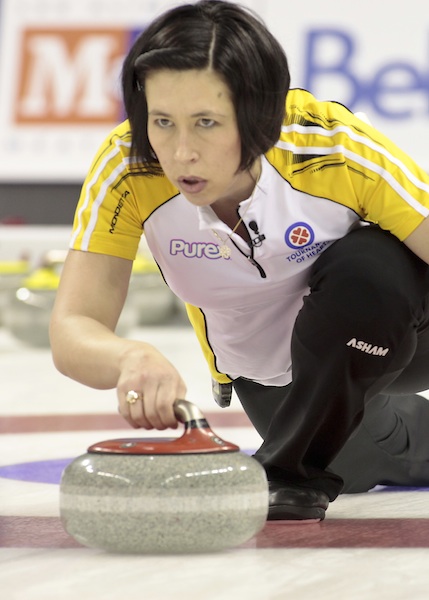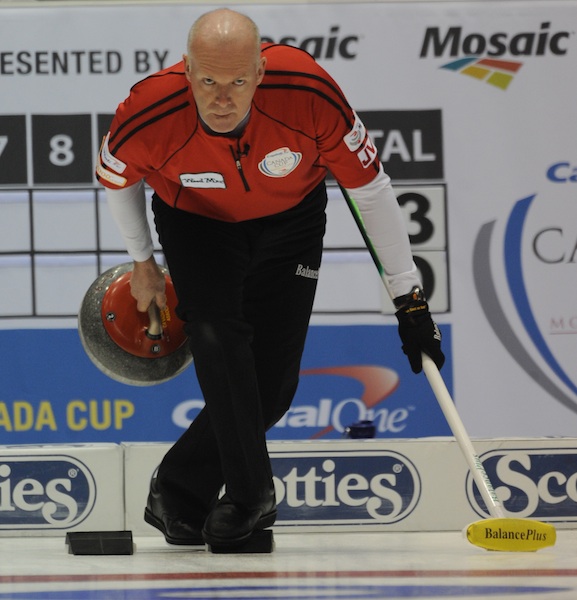House Call: Tips for take-outs
A new curler sits in the hack staring at her skip at the far end. Her worst nightmare of a shot is being called; a take-out.
As she stares down the broom she recalls past issues with attempted take-outs. Though she occasionally makes a hit successfully more often than not she finds she is either too heavy, too light, off the broom or some combination of the three.
Often even the most experienced curlers end up missing hits because they sacrifice accuracy for weight. Please don’t get me wrong; the ability to throw very heavy hit weight with accuracy can be a wonderful secret weapon (Thank you, Jill Officer). However, curlers like Officer practice throwing the high hard ones more than I can even imagine. For those of us not practicing almost every day of the week, here are three things you can do to improve your hitting skills and become more consistent.
Board weight isn’t boring
Board weight means the thrower must only throw the stone hard enough to just touch the back boards at the far end and perhaps bounce off slightly. Most curlers will be able to muster the leg drive needed to achieve this weight with accuracy. The sweepers can easily keep up with board weight. Also the skip gives the thrower a little more ice than for a harder hit so they have more time to call line accurately.
If you and your team start to use board weight more often, you will soon discover a lot can be accomplished with it. It works great for when the opposition’s stone is partially buried, as it will curl more than a harder hit. Often throwing board weight can be enough for a double or partial double take-out. Just make sure you decide as a team what board weight means to you and try to practice what it feels like to throw a few times before using it in a game if possible.
Keep your eye on the broom
Many curlers tend to look down at the ice when they pull the rock back towards the hack and elevate their hips. It’s a motion that reminds me of those toy birds rocking back and forth to dip their beaks in the water. This is a motion you should avoid because not only do you lose sight of your target, but it also creates instability that can cause you to lean heavily on the stone. This means you’ll have to push the rock at the end of the slide and likely lose the line of the boom you’re aiming at. You may also end up moving the broom you’re holding into a less stable position which can again cause you to lean on the rock.
To correct this make sure when you pull your rock back towards your hack foot you elevate your hips and only your hips. Keep your head as well as your shoulders level, keep your eyes on the broom and push straight out towards the target.
It can be hard to tell if you have the bad habit of looking down because the delivery happens quite quickly. Ask the players on your team to watch for it. If you do have this habit, try to schedule some practice ice to work on correcting it, or if there is an instructor at your curling club, ask for a lesson to work specifically on the backwards motion of the slide and take-outs.
Hack foot placement
Hack foot placement is extremely important. Not only do you want to make sure you point your toes towards the broom, you also need to make sure your foot isn’t buried way down in the hack as this will greatly diminish your aim and ability to drive out of the hack hard enough with your leg to achieve hit weight or sometimes even draw weight.
We generally tell curlers to place the ball of their foot midway up the hack. This works well for most people but if you find yourself having difficulties throwing board weight or harder you may wish to try moving your foot up slightly higher in the hack. This will give you better leverage when you thrust forward out of the hack.
Hopefully these tips will improve your hit game. Remember not to be discouraged if you don’t see a change in weight right away. When something in your delivery has been corrected or altered it takes time to gain confidence with the new skill. If you give it time and practice for a few minutes when you can squeeze it in, the changes will soon start to work for you and make you more comfortable and competent with take-outs.






